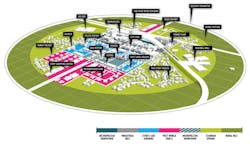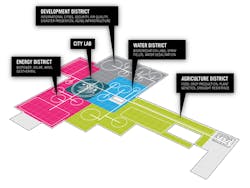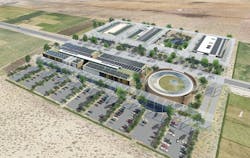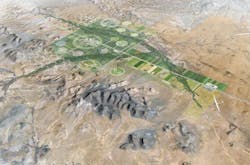CITE: World’s First “Ghost Town” for Testing New Technologies
This file type includes high resolution graphics and schematics when applicable.
Computer modeling and simulation are great tools for testing and evaluating new devices, technologies, and products. But the ultimate test is the real-world marketplace, where customers will use (and abuse) products in ways their inventors and developers never imagined. Unfortunately, going to market is an extremely expensive and risky form of product testing.
To extend the capabilities of product and technology testing—and take some of the risk out of bringing them to the marketplace—the Pegasus Global Holdings, LLC, plans to construct a privately owned city near Deming and Las Cruces, N.M. It will be sized for 35,000 residents, complete with a power plant, buildings for housing, commercial activities, and factories, as well as telecommunication and transportation networks.
But there will be no residents living in this city, nor output from its factories, and no students graduating from its school or worshippers gathering in its church. Instead, the city, currently called the Center for Innovation Testing and Evaluation (CITE), will let clients deploy new technologies and products in full-scale urban, suburban, and rural settings and give them a thorough evaluation. And if a specific research project requires the temporary inclusion of people in the city, CITE can easily accommodate such a request.
The CITE Layout
CITE, which will take four years to build (and will be built in phases), will center on a six-square-mile City Lab. It will contain almost all the infrastructure needed for the 35,000 hypothetical citizens, including highways and streets, a light-rail system, a downtown area, and a big-box store and mall, as well as a variety of different housing and commercial structures.
Buildings will be fully equipped and built to the local codes of New Mexico. Houses will have lights and appliances, offices will have computers, copiers and other equipment, and the hospital will even have an X-ray machine and other medical devices. “It will not be built as a futuristic ‘smart’ city,” says Robert Brumley, a senior director at Pegasus, a Washington D.C. firm with over a decade of experience in developing intellectual property, including extensive experience in testing and evaluating new technologies at federal sites. “Instead, it will represent a turn-of-the-century slice of America.“
Brumley points out that most cities in the U.S. are a long way’s off from being smart cities, which is why the technologies and devices that will be tested at CITE will be targeted at typical U.S. cities.
CITE will also have a functioning power plant, likely a natural gas plant. It will generate 10 MW of power for the city. A desalination plant in the adjacent Water District on CITE will explore bioremediation methods and new ways to make brackish water potable. (New Mexico sits atop 15 billion acre-feet of brackish or saline water.) There will also be a waste-water treatment facility. The electric and water plants will be enough to supply a city of 35,000. If there is excess electricity or fresh water—almost a certainty, given there are no residents—Pegasus plans on selling it to New Mexico utilities and feeding it into their local water and power grids. This would provide an additional revenue stream independent from those created by clients paying to use the CITE facilities.
Other areas surrounding the City Lab include the Energy District, where solar, wind, hydrogen, thorium, geothermal, and other green energy plants generating up to 85 MW of electricity can be set up. The plants will run at their rated power, and possibly higher as technicians “stress” the technology and engineering.
The Agricultural District will be where crop production, plant genetics, and drought/disease resistant schemes can be tested, as well as new farming methods. And the Development District will be set up to evaluate air-quality equipment, aging infrastructure issues, and urban security devices and plans. All of the districts will have field labs set up as workspaces for researchers, clients, and monitoring equipment.
For the City Lab, the workspaces and offices and workspaces for 350 CITE employees and clients will be underground. They will monitor tests and experiments, making sure data is properly recorded and stored, while not interfering with the test conditions.
Why New Mexico?
Though CITE is loosely based on a North Carolina city of 35,000 residents, it will be built in New Mexico—and for several reasons. One of the most important reasons is that Pegasus has the enthusiastic support and endorsement of the New Mexico state government, which has entered into an exclusive development agreement for the project through its Economic Development Department. It’s also an advantage that the state has an extensive and cost-effective infrastructure for power, water, transportation, and communications. In addition, the state boasts a well-educated population and hosts several major universities and research facilities, such as Sandia National Laboratory. “The state has lots of open land for use that is close enough to significant population centers from which to draw employees, but still sufficiently remote to ensure no public safety issues or interference from test activities,” he says.
At the entrance to CITE, Pegasus plans on building a research campus to house more labs and collaborative spaces, along with an administration center to manage CITE. A data center located in the campus will be used by CITE, and like power and water, excess data handling capabilities will be leased to commercial and government entities. The campus will also serve as a security gate between CITE and the outside world. CITE will have significant, strict access restrictions and procedures for storing and transmitting data, says Brumley.
To tie the entire city together, a telecommunications and data transmission backbone will connect all the labs and campus. IT will be shielded against electromagnetic interference.
What it Will Offer
Clients, which will include small and large companies, universities, and governments, will pay a range of fees to access the world’s largest testing and evaluating center. CITE’s criteria for selecting and scheduling clients’ tests will be partially based on whether the technology, product, or service is tied to a significant potential growth sector of the U.S. economy; whether the testing needs the resources of CITE’s large-scale, real-world facility; and if the test could lead to new products or devices being marketed in the real world with no major upgrades in infrastructure. The fee structure for CITE testing has yet to be determined, but CITE planners would have to set them competitively to draw clients.
Because CITE will be run privately, it will not have security, scheduling issues, and other limitations common at Federal labs and large corporate test labs. Nor will there be issues or red tape with keeping intellectual property secret and under wraps, which is a constant concern to inventors who take new ideas to large companies, as well as at university labs and facilities. CITE also plans to offer lower fees to companies and universities that partner with them in building and developing the test city.
Once CITE is up and running, which should be sometime in 2020, it will help companies and individuals take new ideas from prototype to a fully vetted and tested commercial product. To this end CIT will provide a wide array of services. These include:
Innovation support: CITE personnel would help commercialize new technologies or product ideas and help clients find partners. They would also help in defining capabilities, developing a business plan, and handling marketing, packaging, and delivery.
Test design: The facility will provide technicians to run tests, if needed, or simply assist in planning and designing the tests. This would include developing test objectives, plus designing and building physical test rigs. The facility could also help check and analyze test results and make recommendations for the next round of testing, if necessary.
Data distribution: A CITE cloud will let clients configure, monitor, and assess tests remotely at their facilities, as well as at their office spaces leased on the CITE campus.
Consulting services: CITE will also offer clients an opportunity to work with America’s leading firms and innovative start-ups to expose them to the skills, processes, organizational structures, and disciplines that will let them leverage their capabilities in meeting customer needs and becoming market leaders.
The Pegasus team has yet to acquire regulatory licensing (a key to CITE’s operating system), and it needs to finalize financing (which depends on licensing). It will take four years to build the CITE core, but Pegasus believes it can shave dix months off that timeline by starting construction on the City Lab and underlying infrastructure for the entire CITE at the same time, and that depends on the availability of workers, permits, and capital. It’s also possible CITE could host tests before the complex is fully built.
Potential CITE Test Scenarios
While the range of testing scenarios that could be done at CITE are virtually unlimited, IoT-related technologies are a prime example of what could be tested. In recognition of this, London-based Total Telecom recently named CITE the recipient of its distinguished Internet of Things Awards (IOTA), owing to its contributions to the IoT infrastructure.
Brumley and his team at Pegasus have also outlined several potential test scenarios that revolve around security.
For example, a handful of companies are developing and using equipment that takes acoustical and other data collected from a network of widely separated sites to triangulate and locate the source of gunshots. Those firms could test and certify their equipment in CITE, a realistic representation of a city or suburb, complete with echo-inducing buildings and urban “canyons.” They would be free to fire different types and calibers of weapons at any time of day and in any weather without worrying about hurting or alarming the public.
Sensors for detecting biological and chemical attacks, as well as the equipment and tactics used to combat them, could also be tested and evaluated. Those attacks could be carried out against high-rises, schools, or even CITE’s highways and mock airport. Researchers could track the spread of the biological or chemical agents as they make their way from single or multiple release points and are subject to real-world airflows and weather in downtown or suburban areas.
They could also test HVAC systems designed to keep out chemical agents or render them harmless. Events could occur simultaneously with hostage-taking assaults that confuse security forces while cyber-attacks try to overcome security software and hardware.
Security forces and the companies that make weapons and tools for them could try out there new techniques and technologies in actual downtown or commercial settings. This would include advanced electro-optical and infrared detections systems and non-lethal weapons. Another possibility is testing new emergency communication devices in combination with others to ensure there is no interference. Transmission and reception testing could easily include a host of different sized buildings and environments, including weather. Researchers could closely monitor a fleet of them as they went about a series of simple and complicated tasks and interactions, all without endangering pedestrians. Communications schemes between autonomous vehicles using sensors and transmission equipment from a variety of companies could be tested together to ensure interoperability, guaranteeing they won’t interfere with each other.
Other IoT related tests could include:
· Demonstrating the usefulness and reliability of autonomous robots to maintain and repair urban infrastructure, such as underground pipelines.
· Testing machine to machine (M2M) wireless and wired connections for industrial automation, logistics, smart energy and transport grids, healthcare, and defense.
This file type includes high resolution graphics and schematics when applicable.







